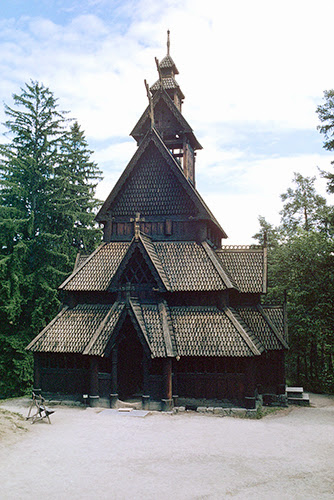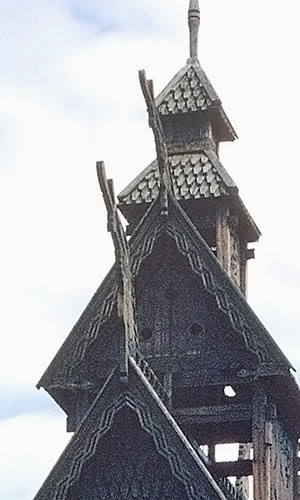Vikings: Gol Stave Church
I know there’s a popular cable show called Vikings. I’ve watched a few episodes, but, as an historian and art historian, I find it really doesn’t address many of the cultural contributions Scandinavians (Sweden, Norway, and Denmark) made to Western art.
I’m especially appalled by the emphasis on the violence. Granted, the Vikings weren’t the most loveable people from the period of the late Roman Empire (ca. 284–500 CE) to the early Romanesque period (ca. 1000–1200), but, come on, their culture was about more than just plunder and pillage. I think their aesthetic contributions are comparable to those of the “Christianized” Anglo-Saxons in Britain in the period between the 700s and the 1000s. One of their greatest legacies is their artistry with wood sculpture, relief, and architecture.
 |
| Norway, Gol “stave” church near Oslo at the Norwegian Museum of Cultural History (a replica now exists in Gol), ca. 1235–1265. © 2014 Davis Art Images. (8S-26082) |
Until Scandinavians accepted Christianity (Denmark in the 900s, and Norway and Sweden in the course of the 1000s), their buildings were exclusively of wood. It is often theorized that this reliance on wood as a building material is what made the Vikings such able ship-builders. As seafaring folk, the Vikings raided and established settlements in Britain, Normandy, and Tuscany, and their raids extended sometimes to Spain, Germany, and western France. Their master seafaring abilities enabled them to establish colonies in Iceland (c. 860 CE) and Greenland (c. 965 CE).
But, let’s get away from Viking “marauding.” The idea diminishes the focus on their arts. Carving was the primary fine art, from everything from ship prows to the doorways of churches. A characteristic of Viking relief carving was complicated interlace terminating in a leaf or animal head, very similar to Celtic art. The Viking expertise in wood carving and building definitely influenced church decoration. The term “stave church” comes from the basic element of building with wood, particularly ships: a vertical rib upon which were attached horizontal planks sealed with tar. One can see on the Gol church a couple of prow-like sculptures protruding from the uppermost eaves, perhaps reflecting the decoration of the bows of ships. The complex wooden shingling reminds us that architecture can be one of the finest sources for the element of art of “texture.”
 |
| Norway, Gol “stave” church near Oslo at the Norwegian Museum of Cultural History (a replica now exists in Gol), detail, ca. 1235–1265. |
In form, the stave churches were usually in a centrally planned, Greek cross-like organization (wings of equal length from a central worship area). The introduction of stone church construction from mainland Europe, influenced by the blooming Romanesque style of the late 1100s to early 1200s, essentially ended the stave church style, although it was employed sporadically in Scandinavia and the British Isles. Luckily, many stave churches have survived to this day.
Correlations to Davis programs: Explorations in Art Grade 4: 3.18, Studio 17–18; A Community Connection: 5.5; A Global Pursuit: 3.4; The Visual Experience: 11, 15.6; Discovering Art History 7.4


Comments